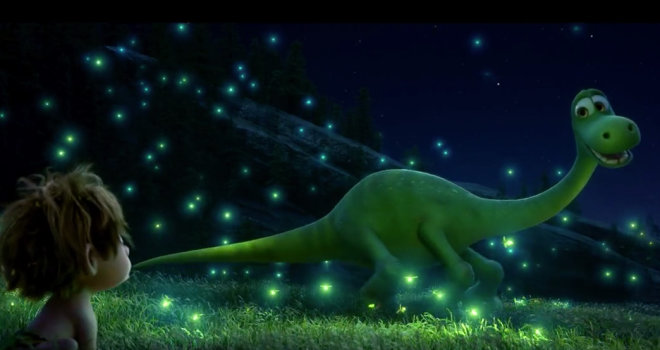Since the release of Pixar’s first feature-length film, Toy Story, the company has been keen to cast non-human characters in their productions. Toy Story and its sequels hosted a cast of children’s toys, while more recently, box office smash Inside Out employed emotions as its leads. Interesting though these choices have been, the animation giant has up to now managed to avoid casting truly unrecognisable characters. The toys central to Toy Story and the emotions in Inside Out are all drawn from the average human experience, sparking a sense of familiarity in the minds of the audience.
The Good Dinosaur, Pixar’s most recent movie, marks a departure from this tradition. The protagonist, Arlo (Raymond Ochoa), is a dinosaur and the film’s prehistoric world is most unlike our own. Were this any animation studio other than Pixar you could imagine that this kind of setting would hamper the movie’s pace by forcing characters to over-explain themselves. But this is a Pixar movie, so it makes the story more intriguing, the art more vibrant and the characters more empathetic.
The Good Dinosaur is set in an alternative world, one in which dinosaurs were not wiped out. The young Arlo and his family are farmers, capable of building structures and of course communicating. Within the first few minutes we learn that Arlo is uncharacteristically cowardly for a dinosaur. His fear prevents him from making any contribution to the family farm and his parents fail to help him overcome his terror of almost everything. Shortly thereafter, Arlo falls into a river and is separated from his family. His attempt to journey home and his developing friendship with a human child constitutes the plot of the film.
The interesting thing about this friendship is that it inverts the traditional relationship between humans and their animal companions in animated films. Arlo is fully capable of speech, and his behaviour is much more recognisably human than the behaviour of the prehistoric human child, Spot. The characters can’t understand each other’s speech (if Spot’s grunts can be termed as such) and the child fulfils a similar role to the animal companions in films such as Pocahontas or The Little Mermaid. Much of the film’s slapstick humour comes from the contrast between Arlo’s frightened, human reactions and Spot’s aggressive dog-like behaviour.
The Good Dinosaur is a very funny film and features humour aimed separately at children and adults ensuring that both laugh during the same scenes. Indeed, even the slapstick sections are capable of entertaining the adult viewer as they are illustrated with remarkable care and skill. That is to say, when a shelter collapses on Arlo we can see all the elements leading to this point in frame before it happens and predict the likely punchline. This is ultimately closer to Charlie Chaplin’s slapstick (featuring a problem, setup, and punchline) than other animated films which offer a punchline from nothing. As for the adult humour, there is a bizarre, hilarious encounter with a Styracosaurus (Peter Sohn) – a scene we’re meant to take as an accidental hallucinogenic high.
These scenes are of particular delight for the adults in the audience, acting as unexpected interludes in an otherwise predictable plot. Individual scenes and characters in The Good Dinosaur are often inventive – it is a real treat to see how Pixar defies stereotypes of particular dinosaur species – but the larger arc will be familiar to anyone who watched Brother Bear or other older animated “journey” films. The Good Dinosaur elevates itself above those movies largely in its eloquent method of telling a familiar story. Nothing happens without the audience understanding its significance. When Arlo falls into the river, for instance, the danger is apparent due to some clever foreshadowing in the opening scene.
It is the film’s creativity, though, that brings into sharper focus a criticism of the animation in The Good Dinosaur. The style of Arlo and his family are unsuited to the world they occupy. Arlo is rendered from very simple shapes with rounded edges fitted together as smoothly as possible. This would be fine, except that the world in which the film is set is as realistic as anything Pixar has ever created. When Arlo emerges from the impressively true-to-life water and grabs astoundingly detailed pieces of wood, it’s jarring that he himself has such a simplified form. However, clearly that simple style is useful since it makes characters easy for young children to recognise. In that case though, the characters’ world should have been changed to suit them. Instead, the end result is that it looks like a character from The Incredibles was dropped into the world of Brave.
The Good Dinosaur is a fantastically entertaining film. One of the few criticisms to make of it, aside from its artistic direction, is that some scenes, such as the appearance of the Styracosaurus, are so jam-packed with jokes that they deserve expansion. So full of potential are many of the apparently unimportant moments, both comedic and dramatic, that the length of the film could easily have been doubled. Of course, Pixar is catering primarily to an audience of children and so the relatively short runtime is understandable. In any case, leaving a theatre disappointed only that the movie wasn’t longer is a compliment more so than a criticism. The Good Dinosaur is undoubtedly a candidate for the best film of the year. We can either see it ourselves or envy children as they watch a film created with more thought, care and passion than most produced for an adult audience.







